

Connected Collection: Tinkering in STEM Education. Connected Collections are meant to support professional learning conversations about a particular topic, in this case Learning Through Tinkering in STEM Education.
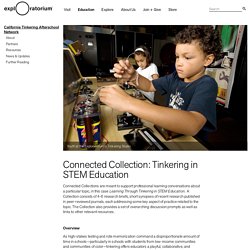
A Collection consists of 4-6 research briefs, short synopses of recent research published in peer-reviewed journals, each addressing some key aspect of practice related to the topic. The Collection also provides a set of overarching discussion prompts as well as links to other relevant resources. Overview As high-stakes testing and rote memorization command a disproportionate amount of time in schools—particularly in schools with students from low-income communities and communities of color—tinkering offers educators a playful, collaborative, and inquiry-based approach to engaging youth in STEM-rich learning. Learning Goals The persistent problem we explore in this collection is how to create imaginative and open-ended STEM-rich tinkering experiences in classrooms and afterschool settings. Summaries of Research Briefs. Learning STEM Through Design: Students Benefit from Expanding What Counts as "Engineering"
Embed Literacy into STEM Projects. (Originally posted at ISTE.org) STEM is nothing without literacy.
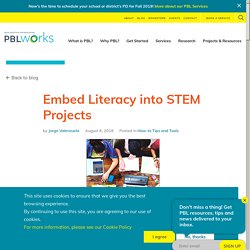
As STEM/STEAM educators, we want to help students think and work like engineers and computational thinkers. But that involves more than introducing students to the design process or teaching them about technology tools. The work of engineers also involves collaboration, communication, global citizenship and literacy skills. During my tenure as supervisor of the Technology and Engineering Education(TEE) program at Richmond Public Schools (RPS), improving the reading and writing skills of our students was just as important as developing their technical literacy. I recommend that STEM teachers employ the following four strategies for helping their learners improve their literacy skills.
Organize literacy content in STEM lessons If you focus on the areas your students struggle with most, they will be able to improve their literacy skills over time through consistent practice. Use the jigsaw protocol Giving presentations. You searched for steam - Defined STEM. STEAMPortal. Welcome to the K12 Lab Network wiki! Design thinking is a methodology for creative problem solving.
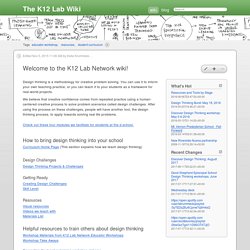
You can use it to inform your own teaching practice, or you can teach it to your students as a framework for real-world projects. We believe that creative confidence comes from repeated practice using a human-centered creative process to solve problem scenarios called design challenges. After using the process on these challenges, people will have another tool, the design thinking process, to apply towards solving real life problems. Check out these tour modules we facilitate for students at the d.school. How to bring design thinking into your school Getting Ready Resources Helpful resources to train others about design thinking Workshops and materials from our network. Where the Art Studio Meets the Makerspace. STEAM Tank Challenge - New Jersey School Boards Association. The STEAM Tank Challenge, created and sponsored by NJSBA and the U.S.

Army, encourages New Jersey’s public school students in the areas of STEAM – science, technology, engineering, the arts, and math. The competition asks the district teams to invent something new, modify an existing product, or identify a situation or real-world problem that needs resolution. Teams are provided criteria and a panel of experts judge their designs and/or solutions. Teams presenting must consist of at least two, but no more than five, students and at least one educator. Each team is allowed to present only one idea. STEAM Tank Challenge Finals The final judging of the STEAM Tank Challenge submissions will take place at the NJSBA/NJASA/NJASBO Workshop on Oct. 22 and 23, 2019. Take Part in STEAM Tank Challenge 2020 Applications for the 2020 competition are now available here: STEAM Tank Regional Application. For additional information or clarification please email steamtank@njsba.org. ArtsintegrationWorkbook2018. NGSS Resources. Engineering Design Process.
In STEM education, engineering—the process of designing, building, and using engines, machines, and structures—is often ignored even though it is the key to authentic STEM instruction.
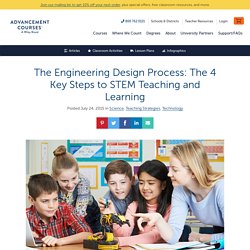
For some teachers, engineering is intimidating as it’s rarely mentioned in science, math, or technology teacher preparation. For others, it’s daunting. It seems like a lot of planning to successfully implement an engineering design project, which is not essential to science, math, or technology instruction. Why STEM Teaching Matters?
Resources and Downloads for STEM. STEM Is Jambalaya: Internalize this food metaphor to shift into a STEM mindset.
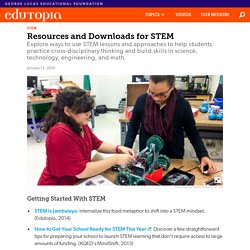
(Edutopia, 2014) How to Get Your School Ready for STEM This Year: Discover a few straightforward tips for preparing your school to launch STEM learning that don’t require access to large amounts of funding. (KQED's MindShift, 2013) 10 Innovative Ways to Bring STEM to Schools: Explore ideas for bringing STEM learning into schools, including teacher research and development teams, inviting guest scientists, organizing clubs, and convening parent focus groups. (KQED’s MindShift 2014) Periodic table of #STEAM iPad apps. First things first.

As I started in my last periodic table post, it’s never just about the apps. End of. That said being guided around tried and tested apps from the classroom can be really helpful. Home - Rethinking Schools. TeachThought - We Grow Teachers. KQED Public Media for Northern CA.